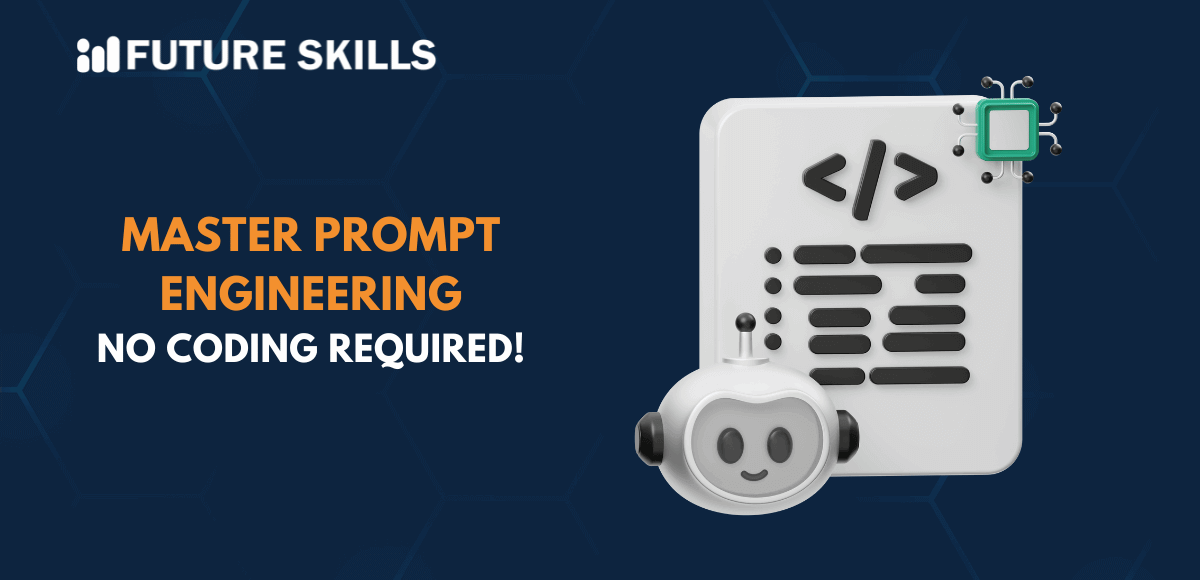Large Language Models, or LLMs have been phenomenal contributors to the growth of the AI landscape. They have shown promise in addressing crucial tasks such as machine translation and sentiment analysis. On the other hand, a chain-of-thought prompting guide or CoT guide is essential to think of potential solutions for complex multi-step problems like general and arithmetic reasoning.
You can fine-tune LLMs for such types of specific tasks or teach them with few examples through few-shot prompting. However, both these methods have certain limitations, such as higher costs and lack of effectiveness. Interestingly, Chain of Thought prompting can help you address such setbacks in your interactions with LLMs. Let us learn more about Chain of Thought prompting, its different variants, and the best practices for using it in generative AI systems.
Learn how to use AI technology to the fullest with accredited Certified Prompt Engineering Expert (CPEE)™ course. Get hands-on experience in writing precise prompts from industry experts and become a professional.
Fundamental Concepts of Chain of Thought Prompting
Chain of thought prompting is a crucial requirement for the AI landscape as it is an advanced prompting technique. The answers to “What is Chain-of-Thought prompting?” indicate that it is a powerful prompt engineering technique that helps LLMs generate a series of steps between the input and the output that break down the larger problem into smaller tasks.
One of the striking highlights of CoT prompting is the ability to improve the reasoning capabilities of LLMs. The prompting technique is useful as it helps the model emphasize one subtask before moving to the next instead of solving the complete problem in one step. It opens up a comprehensible window or explanation for how the model works in a specific way. You can notice how the language model generated a specific response by following a particular combination of steps.
The best ways to identify Chain of Thought prompting ChatGPT applications would involve looking for LLMs that work with large collections of parameters. It is useful for working with LLMs on different reasoning tasks, such as symbolic manipulation, arithmetic word problems, and commonsense reasoning.
You can notice examples of how Chain of Thought prompting has helped improve LLMs, such as PaLM. CoT prompting helped in elevating the performance of the PaLM model on the GSM8K benchmark to 58.1% from the baseline performance of 17.9%. You can readily deploy CoT prompting in LLMs with a significantly larger number of parameters without any fine-tuning or special training.
Develop practical expertise in generating content using AI and ChatGPT with our free ChatGPT and AI Fundamentals Course. Grab the opportunity to boost your productivity and transform your career.
Variants of Chain of Thought Prompting
The next important aspect in understanding chain of thought prompting involves a review of the different variants. You can find the two most common variants of a chain of thought prompting in few-shot CoT and zero-shot CoT prompting. Here is an overview of the distinct highlights of the two variants.
-
Few-Shot CoT Prompting
Few-shot prompts can instruct an LLM to work towards a specific objective with the help of a question-and-answer format. Subsequently, the CoT prompting involves providing certain examples to the LLM on how it can solve problems that are like the examples. The examples in a Chain of Thought prompting LangChain framework would showcase that the examples must be used in a specific way. The examples must encourage the LLM for reasoning to resolve the problem and generate new chains of thought leading to correct responses.
A few-shot chain of thought prompting is an effective choice to enhance the capabilities of LLMs for reasoning compared to the baseline few-shot prompts. It might have higher complexity as it demands the development of prompts that can serve as examples. On the other hand, benefits of the prompting technique can always stand above the complexity associated with it.
-
Zero-Shot CoT Prompting
Zero-shot prompts work by adding step-by-step thinking instructions in the actual prompt. The approach helps in the extraction of reasoning alongside answers by utilizing two prompts. The reasoning extraction step involves language models thinking about the intricacies of a question, followed by the creation of a specific sequence of reasoning steps to come up with an answer. In the next step, you have to obtain the final output from the response of the language models. Zero-shot chain of thought prompting is better than other methods associated with training LLMs to work on different reasoning tasks.
What are the Important Elements of CoT Prompting?
Chain of Thought prompting can get better with optimization of important elements used in their working mechanism. Any chain-of-thought prompting guide can help you identify the key elements that make CoT prompting successful. You must know that certain important dimensions of Chain of Thought prompting can influence its reliability and performance in LLMs. Here are the important dimensions that play a crucial role in improving the productivity of Chain of Thought prompting.
-
Self-Consistency
Self-consistency serves as an important technique that helps with the improvement of language model performance in the case of tasks that focus on reasoning across multiple steps. Self-consistency plays a major role in fuelling improvements in the performance of language models with chain-of-thought prompting. It can ensure the sampling of multiple chains of thought with diverse traits for a specific problem. Subsequently, the model would go through a training process to choose the answer with the best consistency.
-
Sensitivity
Sensitivity is another notable trait in CoT prompting that signifies the degree to which the design of prompts affects their performance. Some of the chain of thought prompting examples can help in verifying that the performance of the model may deteriorate when you don’t have well-designed prompts. The prompts must maintain clarity, easier understandability, and conciseness. It is important to refrain from the use of jargon or technical terms that are new to the model.
-
Robustness
Chain of Thought prompting does not depend on a specific linguistic style. It must remain robust even with a larger number of examples. In a way, CoT prompting is distinctive in the fact that it does not need a large count of examples to achieve better effectiveness. On top of that, the performance of CoT prompting does not depend on the language model you use.
-
Coherence
Another crucial trait that you might use for CoT prompting is coherence. It points out the degree to which the steps in chain-of-thought prompting are in the correct sequence. It suggests that the later steps cannot serve as preconditions for the earlier steps. On the other hand, the earlier steps should not be the derivatives of the later steps.
Discover the best career path in AI and boost innovation through AI by enrolling in Certified AI Professional (CAIP)™ Certification. Dive deep into AI’s practical applications and learn complex concepts from industry-leading experts.
What are the Benefits of Chain of Thought Prompting?
The discussions about the capabilities of LLMs for a chain of thought prompting might also draw your attention toward the technique’s advantages. You can use the Chain of Thought prompting LangChain framework interplay to implement CoT prompts effectively. On the other hand, it is important to know what you can gain from the technique for interacting with LLMs.
First of all, Chain of Thought prompting enables the breaking down of complex problems into smaller tasks. As a result, LLMs can process the smaller components with better efficiency, thereby improving the precision and accuracy of model responses.
Chain of Thought prompting can also help capitalize on the extensive general knowledge of LLMs for specific tasks. LLMs learn different types of definitions, problem-solving examples, and explanations in their training process. Therefore, they can capitalize on the massive reserves of stored knowledge to solve specialized tasks.
Another crucial detail in the responses to “What is chain-of-thought prompting?” is the ability to resolve one of the common setbacks of LLMs. CoT prompting can help in addressing problems with logical reasoning. With a structured reasoning approach, CoT prompting can guide the model toward creating a logical pathway from the query to the final solution.
The most noticeable advantage of a chain of thought prompting would draw attention to the assurance of support for debugging and improving models. CoT prompting ensures that users can find out how a model arrives at specific responses.
What are the drawbacks of Chain of Thought Prompting?
While Chain of Thought prompting is a reliable prompting technique for advanced and complex tasks, it is also important to understand its limitations. Most important of all, you must remember that the LLM is a neural network that predicts text sequences on the basis of probability. Therefore, it is important to understand that LLMs cannot mimic the reasoning capabilities of humans. You must always establish realistic expectations about the capabilities of LLMs while using CoT prompting.
Another important highlight in a chain-of-thought prompting guide would draw attention to the fact that LLMs don’t have metacognition or consciousness. The general knowledge of LLMs depends on their training data and may have errors, biases, and gaps. While CoT prompting can help in structuring the LLM output, an LLM could also present coherent outputs with logical errors.
You must also note that the scalability of a chain of thought prompting is still in question. The massive size of LLMs demands large amounts of data, infrastructure, and computational resources, thereby raising issues for accessibility, sustainability, and efficiency.
Final Words
The use of chain of thought or CoT prompting can spell new advancements in the domain of prompt engineering. It is a useful method for guiding LLMs to work on complex tasks by breaking them into smaller steps. The review of different chain of thought prompting examples helps in understanding the significance of CoT prompting. In addition, you can try different variants of CoT prompting according to your objectives. Learn more about prompt engineering and find the ideal ways to use a chain of thought prompting to your advantage now.






